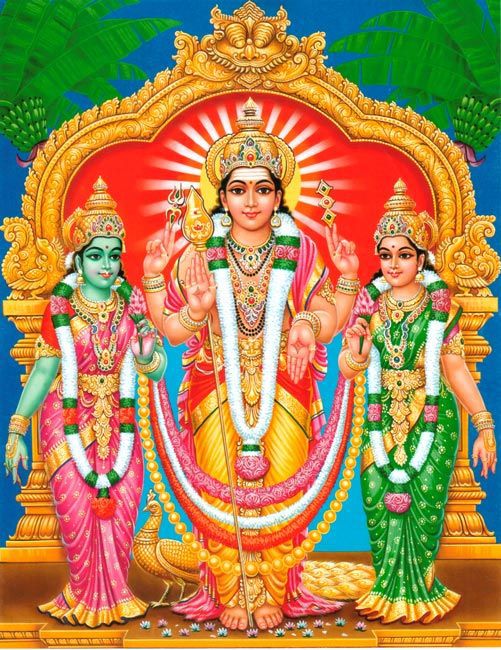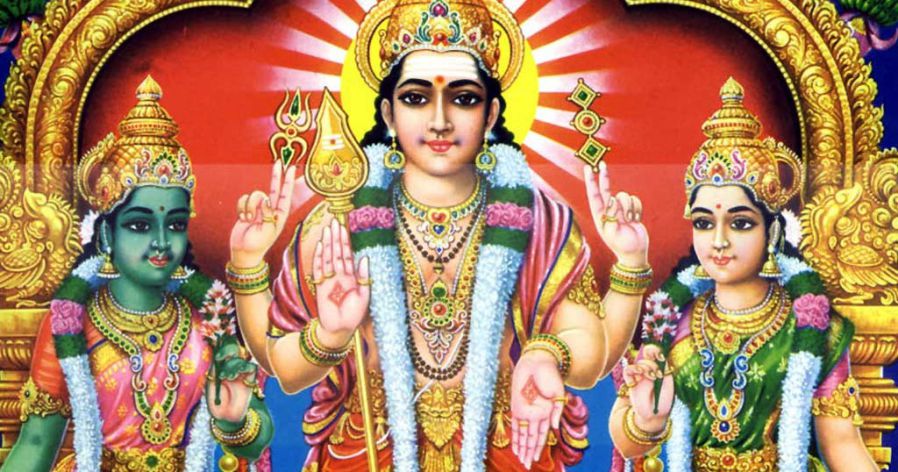No products in the cart.
Lord Murugan, the son of Shiva and Parvati, is a much revered deity of Hindus especially in South India. He is known by various names like Kartikeya, Shanmukha (Shanmuga), Subramanian, Shadanana, Guha, Senthil, Saravana, Kumaraswamy and Skanda ( Refer 108 Names of Lord Murugan). His six most important shrines in India are the Arupadaiveedu or the Six Abodes of Murugan, which are temples located in Tamil Nadu. Murugan rides a peacock and wields a bow in battle. During His bachelorhood, Lord Murugan is also regarded as Kumaraswami (Bachelor God), ‘Kumara’ meaning a bachelor and ‘Swami’ meaning God.
The Two Wives of Murugan
According to the legend, Murugan is married to two deities. The first one is Devasana (also called Devayani or Deivanai), the daughter of Lord Indra and his second wife is Valli (she was found in a pit, dug out while gathering the edible tubers of the valli-plant), the daughter of a tribal chief. The two wives of Lord Murugan, namely Devasena and Valli refer to Kriya Shakti and Ichha Shakti, meaning the Power of Action and Power of Will respectively, while Lord Murugan represents Gyana Shakti or the power of Wisdom.
In her previous birth Valli & her sibling Devasena were the daughters of Lord Vishnu & both of them undertook several penance to became the consorts of Lord Murugan, who appeared before them & gave them the boon of the marriage in their next birth. Lord Murugan fulfilled the prayers of both his sincere devotees and demonstrated the power of devotion to the entire world by marrying them both. There is a regular, formal spiritual path prescribed by the Vedas and the other path is the unconventional path characterized by powerful feelings and emotions towards the Lord just leaving aside the mechanic formalities. Devasena and Valli represent these two types of devotion towards the supreme self. Where Valli took the spiritual way, Devasena chose the path of emotions and passion.
Murugan and His Marriage to Devasena
Devasena was gifted in marriage to Lord Murugan by Indra after he vanquished the demons. Devasena was in her previous birth the daughter of Vishnu, the king of Gods, who too did an austere penance to get her wedded to Lord Murugan. The marriage with Devasena happened in the most orthodox way and is described as the Vaidika type of wedding.
Her story is told in the Vana Parva of the Mahabharata.
And considering that this being (Skanda) was undoubtedly destined to be the husband of this lady by Brahma himself, he had her brought there, dressed her with the best apparel. And the vanquisher of Vala then said to Skanda, ‘O foremost of gods, this lady was, even before thy birth, destined to be thy bride by that Self-existent Being. Therefore do thou duly accept her lotus-like beautiful right hand with invocation of the (marital) hymns.’ Thus told, he duly married her. And Vrihaspati learned in hymns performed the necessary prayers and oblations. She who is called Shashthi, Lakshmi, Asa, Sukhaprada, Sinivali, Kuhu, Saivritti, and Aparajita, is known among men as Devasena, the wife of Skanda. When Skanda became united to Devasena in indissoluble bonds of matrimony, then the gods of prosperity in her own personal embodiment began to serve him with diligence.
Murugan and His Marriage to Valli

On the other hand, the story of Murugan’s courtship and his union with Valli, daughter of Nambi Raja, a tribal chieftain of a people called the Veddars or Kuravars, is the most important of all Tamil myths of the second marriage of a God. In her earlier birth, Valli was the daughter of Lord Vishnu and she undertook a severe penance to get married to Lord Murugan. Valli represents the Jiva or the soul under the veil of ignorance. Under the guidance of the Guru Narada, the veil of ignorance is torn away and the soul marches towards liberation or Moksha. This is the symbolic idea represented by the marriage of Valli and Lord Murugan which happened in an unconventional way and is described either as Gandharva or Paisacha kind of marriages.
The Lord saw Valli in the fields and assumed the form of handsome tribal hunter. She asked him to leave as the chief was coming. After the chief left, he changed back into the hunter form and proposed to Valli but she refused. He then changed himself into an old man. He asked Valli for food & she gave him a mixture of millet flour & honey. She provided him with water too to which the lord jokingly remarked that she can quench his thirst for a companion too. However, this remark made her angry so the Lord requested his brother, Lord Ganesha for help. Lord Ganesha appeared as a wild elephant and upon seeing the elephant, Valli ran back to the old man pleading to save her. Lord Murugan proposed to save her only if she agreed to marry him. At the heat of moment, she agreed & Lord revealed his true form. It was then that Valli realized that it was her beloved Lord, who was with her all the time.
Infront of her parents, Murugan assumed his true divine shape. Amazed and awed, the hunters worshipped him and begged him to come to the hamlet to be married in accordance with the custom of the tribe.
The whole village, thus, rejoiced. The young pair was seated on a tiger-skin. Nampi, Valli’s father placed the hand of Valli into the hand of Murugan and declared them married. At that moment, the Gods appeared in the air and blessed everyone. Nampi then offered a feast – plenty of honey, millet flour and jungle fruits. After a short stay at Ceruttani (Tiruttani), Murugan and Valli returned to Skandagiri where they were welcomed by Devasena.






